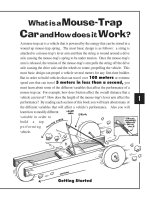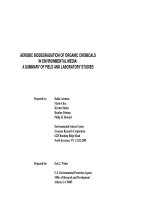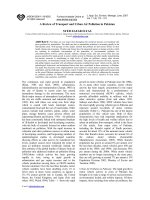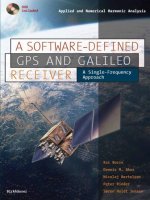A software defined GPS and galileo receiver springer
Bạn đang xem bản rút gọn của tài liệu. Xem và tải ngay bản đầy đủ của tài liệu tại đây (2.23 MB, 189 trang )
Applied and Numerical Harmonic Analysis
Series Editor
John J. Benedetto
University of Maryland
Editorial Advisory Board
Akram Aldroubi Douglas Cochran
Vanderbilt University Arizona State University
Ingrid Daubechies Hans G. Feichtinger
Princeton University University of Vienna
Christopher Heil Murat Kunt
Georgia Institute of Technology Swiss Federal Institute of Technology, Lausanne
James McClellan Wim Sweldens
Georgia Institute of Technology Lucent Technologies, Bell Laboratories
Michael Unser Martin Vetterli
Swiss Federal Institute Swiss Federal Institute
of Technology, Lausanne of Technology, Lausanne
M. Victor Wickerhauser
Washington University
Applied and Numerical Harmonic Analysis
J.M. Cooper: Introduction to Partial Differential Equations with MATLAB
(ISBN 0-8176-3967-5)
C.E. D’Attellis and E.M. Fern´andez-Berdaguer: Wavelet Theory and Harmonic Analysis in
Applied Sciences (ISBN 0-8176-3953-5)
H.G. Feichtinger and T. Strohmer: Gabor Analysis and Algorithms (ISBN 0-8176-3959-4)
T.M. Peters, J.H.T. Bates, G.B. Pike, P. Munger, and J.C. Williams: The Fourier Transform in
Biomedical Engineering (ISBN 0-8176-3941-1)
A.I. Saichev and W.A. Woyczy´nski: Distributions in the Physical and Engineering Sciences
(ISBN 0-8176-3924-1)
R. Tolimieri and M. An: Time-Frequency Representations (ISBN 0-8176-3918-7)
G.T. Herman: Geometry of Digital Spaces (ISBN 0-8176-3897-0)
A. Proch´azka, J. Uhli˜r, P.J.W. Rayner, and N.G. Kingsbury: Signal Analysis and Prediction
(ISBN 0-8176-4042-8)
J. Ramanathan: Methods of Applied Fourier Analysis (ISBN 0-8176-3963-2)
A. Teolis: Computational Signal Processing with Wavelets (ISBN 0-8176-3909-8)
W.O. Bray and
ˇ
C.V. Stanojevi´c: Analysis of Divergence (ISBN 0-8176-4058-4)
G.T Herman and A. Kuba: Discrete Tomography (ISBN 0-8176-4101-7)
J.J. Benedetto and P.J.S.G. Ferreira: Modern Sampling Theory (ISBN 0-8176-4023-1)
A. Abbate, C.M. DeCusatis, and P.K. Das: Wavelets and Subbands (ISBN 0-8176-4136-X)
L. Debnath: Wavelet Transforms and Time-Frequency Signal Analysis (ISBN 0-8176-4104-1)
K. Gr¨ochenig: Foundations of Time-Frequency Analysis (ISBN 0-8176-4022-3)
D.F. Walnut: An Introduction to Wavelet Analysis (ISBN 0-8176-3962-4)
O. Bratteli and P. Jorgensen: Wavelets through a Looking Glass (ISBN 0-8176-4280-3)
H.G. Feichtinger and T. Strohmer: Advances in Gabor Analysis (ISBN 0-8176-4239-0)
O. Christensen: An Introduction to Frames and Riesz Bases (ISBN 0-8176-4295-1)
L. Debnath: Wavelets and Signal Processing (ISBN 0-8176-4235-8)
J. Davis: Methods of Applied Mathematics with a MATLAB Over view (ISBN 0-8176-4331-1)
G. Bi and Y. Zeng: Transforms and Fast Algorithms for Signal Analysis and Representations
(ISBN 0-8176-4279-X)
J.J. Benedetto and A. Zayed: Sampling, Wavelets, and Tomography (ISBN 0-8176-4304-4)
E. Prestini: The Evolution of Applied Harmonic Analysis (ISBN 0-8176-4125-4)
O. Christensen and K.L. Christensen: Approximation Theory (ISBN 0-8176-3600-5)
L. Brandolini, L. Colzani, A. Iosevich, and G. Travaglini: Fourier Analysis and Convexity
(ISBN 0-8176-3263-8)
W. Freeden and V. Michel: Multiscale Potential Theory (ISBN 0-8176-4105-X)
O. Calin and D C. Chang: Geometric Mechanics on Riemannian Manifolds
(ISBN 0-8176-4354-0)
(Continued after index)
Kai Borre
Dennis M. Akos
Nicolaj Bertelsen
Peter Rinder
Søren Holdt Jensen
A Software-Defined GPS
and Galileo Receiver
A Single-Frequency Approach
Birkh
¨
auser
Boston
•
Basel
•
Berlin
Kai Borre
Danish GPS Center
Aalborg University
Niels Jernes Vej 14
DK-9220 Aalborg Ø
Denmark
Dennis M. Akos
Department of Aerospace Engineering
University of Colorado
Boulder, CO 80309
U.S.A.
Nicolaj Bertelsen
Hornbækvej 116
DK-9270 Klarup
Denmark
Peter Rinder
Vivaldisvej 148
DK-9200 Aalborg SV
Denmark
Søren Holdt Jensen
Department of Electronic Systems
Aalborg University
Fredrik Bajers Vej 7
DK-9220 Aalborg Ø
Denmark
Cover design by Joseph Sherman.
MATLAB
R
and Simulink
R
are registered trademarks of The MathWorks, Inc.
Mathematics Subject Classification (2000): 34B27, 49-XX, 49R50, 65Nxx
Library of Congress Control Number: 2006932239
ISBN-10 0-8176-4390-7 e-ISBN-10: 0-8176-4540-3
ISBN-13 978-0-8176-4390-4 e-ISBN-13: 978-0-8176-4540-3
Printed on acid-free paper.
c
2007 Birkh
¨
auser Boston
All rights reserved. This work may not be translated or copied in whole or in part without the written
permission of the publisher (Birkh
¨
auser Boston, c/o Springer Science+Business Media LLC, 233
Spring Street, New York, NY 10013, USA) and the author, except for brief excerpts in connection with
reviews or scholarly analysis. Use in connection with any form of information storage and retrieval,
electronic adaptation, computer software, or by similar or dissimilar methodology now known or
hereafter developed is forbidden.
The use in this publication of trade names, trademarks, service marks and similar terms, even if they
are not identified as such, is not to be taken as an expression of opinion as to whether or not they are
subject to proprietary rights.
987654321
www.birkhauser.com (EB)
Applied and Numerical Harmonic Analysis (Cont’d)
J.A. Hogan and J.D. Lakey: Time-Frequency and Time-Scale Methods (ISBN 0-8176-4276-5)
C. Heil: Harmonic Analysis and Applications (ISBN 0-8176-3778-8)
K. Borre, D.M. Akos, N. Bertelsen, P. Rinder, and S.H. Jensen: A Software-Defined GPS and
Galileo Receiver (ISBN 0-8176-4390-7)
Contents
Preface ix
List of Figures xiii
List of Tables xvii
Abbreviations xix
1 Signals and Systems 1
1.1 CharacterizationofSignals 1
1.1.1 Continuous-Time Deterministic Signals 2
1.1.2 Discrete-TimeDeterministicSignals 3
1.1.3 UnitImpulse 3
1.1.4 Rectangular Pulse . 4
1.1.5 Random Signals . 6
1.1.6 Random Sequence of Pulses . . 7
1.2 Sampling 8
1.3 CharacterizationofSystems 9
1.4 LinearTime-InvariantSystems 12
1.5 Representation of Bandpass Signals . . 14
2 GPS Signal 17
2.1 SignalsandData 17
2.2 GPSSignalScheme 18
2.3 C/ACode 20
vi Contents
2.3.1 GoldSequence 20
2.3.2 GoldSequenceGeneration—Overview 21
2.3.3 GoldSequenceGeneration—Details 22
2.3.4 CorrelationProperties 25
2.4 Doppler Frequency Shift 26
2.5 CodeTracking 27
2.6 NavigationData 28
2.6.1 TelemetryandHandoverWords 29
2.6.2 DatainNavigationMessage 30
3 Galileo Signal 31
3.1 SignalTheoreticalConsiderations 31
3.2 Galileo L1 OS Signal . . 33
3.2.1 SignalGeneration 34
3.2.2 Coherent Adaptive Subcarrier Modulation . . 35
3.2.3 Binary Offset Carrier Modulation . . 37
3.3 MessageStructure 42
3.3.1 FramesandPages 42
3.3.2 Cyclic Redundancy Check . . 42
3.3.3 Forward Error Correction and Block Interleaving . . . . . 43
3.4 MessageContents 45
3.4.1 TimeandClockCorrectionParameters 46
3.4.2 ConversionofGSTtoUTCandGPST 48
3.4.3 ServiceParameters 49
3.5 The Received L1 OS Signal . . . . . . 50
4 GNSS Antennas and Front Ends 53
4.1 Background . . . 53
4.2 GNSS L1 Front-End Components . . 55
4.2.1 GNSSAntenna 55
4.2.2 Filter . . 57
4.2.3 Amplifier 59
4.2.4 Mixer/Local Oscillator . . . . 59
4.2.5 Analog-to-DigitalConverter 61
4.3 Resulting Sampled Data 64
4.4 GNSSFront-EndASIC 66
5 GNSS Receiver Operation Overview 69
5.1 Receiver Channels . . . 69
5.1.1 Acquisition . . . 70
5.1.2 Tracking 71
5.1.3 NavigationDataExtraction 72
5.2 Computation of Position 73
6 Acquisition 75
6.1 Motivation 75
Contents vii
6.2 Serial Search Acquisition . 76
6.2.1 PRNSequenceGeneration 77
6.2.2 CarrierGeneration 77
6.2.3 IntegrationandSquaring 78
6.3 Parallel Frequency Space Search Acquisition . 78
6.4 Parallel Code Phase Search Acquisition 81
6.5 DataSize 84
6.6 ExecutionTime 85
6.7 ParameterEstimation 86
7 Carrier and Code Tracking 87
7.1 Motivation 87
7.2 Demodulation . . . 87
7.3 Second-Order PLL 89
7.3.1 DampingRatio 92
7.3.2 NoiseBandwidth 92
7.4 CarrierTracking 93
7.5 CodeTracking 96
7.6 Multipath . 101
7.7 CompleteTrackingBlock 106
7.8 Pseudorange Computations 107
8 Data Processing for Positioning 109
8.1 NavigationDataRecovery 109
8.1.1 Finding the Bit Transition Time and the Bit Values . . . . 109
8.2 NavigationDataDecoding 110
8.2.1 LocationofPreamble 110
8.2.2 ExtractingtheNavigationData 111
8.3 Computation of Satellite Position . . . . 114
8.4 Pseudorange Estimation . . 119
8.4.1 The Initial Set of Pseudoranges 119
8.4.2 Estimation of Subsequent Pseudoranges 120
8.5 Computation of Receiver Position . . . 121
8.5.1 Time 121
8.5.2 LinearizationoftheObservationEquation 122
8.5.3 UsingtheLeast-SquaresMethod 123
8.5.4 Real-TimePositioningAccuracy 125
8.6 TimeSystemsRelevantforGPS 125
8.7 CoordinateTransformations 127
8.8 UniversalTransverseMercatorMapping 129
8.9 DilutionofPrecision 130
8.10 World Geodetic System 1984 . . . . . . 133
8.11 Time and Coordinate Reference Frames for GPS and Galileo . . . 134
Problems 137
viii Contents
A MATLAB Code 143
A.1 StructureoftheCode 143
A.2 The settings Structure 144
A.3 Acquisition Function . . 145
A.4 TrackingFunction 147
A.5 Function postNavigation 148
A.5.1 Pseudorange Computation . . 149
A.5.2 Position Computation . . . . 150
B GNSS Signal Simulation 153
B.1 GPSSignalSimulation 153
B.2 SimulinkImplementation 154
B.2.1 C/ACodeGeneration 155
B.2.2 NavigationDataGeneration 157
B.2.3 PCodeGeneration 158
B.2.4 Combining the Signal Components . 158
B.2.5 Upper-LevelImplementation 158
B.3 Galileo Signal Generator 159
B.4 Differences in Processing GPS and Galileo Signals . 161
B.4.1 SignalDifferences 162
B.5 DifferencesinSignalProcessing 164
Bibliography 167
Index 171
Preface
Software-defined radios (SDRs) have been around for more than a decade. The
first complete Global Positioning System (GPS) implementation was described
by Dennis Akos in 1997. Since then several research groups have presented their
contributions. We therefore find it timely to publish an up-to-date text on the sub-
ject and at the same time include Galileo, the forthcoming European satellite-
based navigation system. Both GPS and Galileo belong to the category of Global
Navigation Satellite Systems (GNSS).
SDR is a rapidly evolving technology that is getting enormous recognition and
is generating widespread interest in the receiver industry. SDR technology aims
at a flexible open-architecture receiver, which helps in building reconfigurable
SDRs where dynamic selection of parameters for individual modules is possible.
The receiver employs a wideband analog-to-digital (A/D) converter that captures
all channels of the software radio node. The receiver then extracts, downconverts,
and demodulates the channel waveform using software on a general-purpose pro-
cessor. The idea is to position a wideband A/D converter as close to an antenna
as is convenient, transfer those samples into a programmable element, and apply
digital signal processing techniques to obtain the desired result. An SDR is an
ideal platform for development, testing of algorithms, and possible integration of
other devices. We have chosen MATLAB
®
(version 7.x) as our coding language
because MATLAB is the de facto programming environment at technical univer-
sities, it is a flexible language, and it is easy to learn. Additionally, it provides
excellent facility for the presentation of graphical results.
The concepts of the present project crystallized nearly 10 years ago. At that
time the technology was not mature enough to be fully realized. Today the various
elements of this interactive book and companion DVD work, and work together:
x Preface
– The main text, which describes a GNSS software-defined radio;
– A complete GPS software receiver implemented using MATLAB as well
as sample data sets—available on the companion cross-platform DVD—
allowing readers to change various parameters and immediately see their
effects;
– A supplementary, optional USB GNSS front-end module, which eventually
converts analog signals to digital signals on a Windows or Linux system
(ordering instructions for this hardware can be found on the bundled DVD).
The signals are imported into MATLAB via the USB 2.0 port.
With all three elements, readers may construct their own GNSS receivers and will
be able to compute a position. Is this not exciting?
A GNSS software receiver is by no means a simple device. The one presented in
this book is a single-frequency receiver using the C/A code on L1 for GPS. This
choice has been made for various reasons. First, it keeps the receiver architecture
fairly simple. Second, with the orbital, clock and ionospheric corrections, as well
as the integrity provided by satellite-based augmentation systems (SBAS) such
as the European Geostationary Navigation Overlay System (EGNOS) and Wide
Area Augmentation System (WAAS), L1 accuracies rival that of dual frequency
GNSS receivers. Only future GNSS wideband signals or additional power will
offer performance improvements over the L1 band. Lastly, the forthcoming Euro-
pean Galileo system will offer an L1 component that will provide greater avail-
ability with its additional full constellation of satellites. We include a description
of the binary offset carrier (BOC) modulation, which is to be used in Galileo, to
allow readers to get acquainted with the new signal type.
The book considers the design of the front-end module, explaining how it is
possible to split the enormous amount of information contained in the antenna sig-
nal into parts related to the individually tracked satellites. Details on purchasing
the front-end module designed for this text can be found at: orado.
edu/gnss.
A complete GPS software receiver was implemented in MATLAB. The receiver
is able to perform acquisition, code and carrier tracking, navigation bit extraction,
navigation data decoding, pseudorange estimation, and position computations. We
were told that nowadays a textbook comes with overheads prepared for the class-
room so that the lecturer’s job is minimized. Actually we have used most of the
present text for various courses during 2004 and 2005, and we are happy to make
this material readily available; it can be downloaded from: gps.aau.dk/softgps.
What follows here is a brief overview of the book’s contents and coverage of top-
ics. Chapter 1 contains a short introduction to deterministic and random signals.
All GNSS codes build on an elementary pulse signal. We investigate its amplitude
spectrum, autocorrelation function, and its Fourier transform, viz. the power spec-
trum. The important sampling process is described. Next, systems and especially
Preface xi
linear time-invariant (LTI) systems are dealt with. This first chapter should give
the mathematically oriented reader a chance to follow the rest of the book. Gener-
ally, the book is written by signal processing people for signal processing people.
The signal structure and the navigation data for GPS are described in Chapter 2.
We deal with the pseudo random noise (PRN) sequences and their correlation
properties in great detail. Doppler frequency shift and code tracking is mentioned.
Finally the navigation data and their format are described.
Chapter 3 has a flow similar to the preceding chapter. We concentrate on the L1
OS signal and binary offset carrier (BOC) modulation, which is new in connec-
tion with navigation signals from satellites. Coherent adaptive subcarrier modula-
tion (CASM) as well as cyclic redundancy check (CRC), forward error correction
(FEC), and block interleaving are described in detail. Finally, the message struc-
ture and contents (navigation data) are dealt with.
Chapter 4 gives an introduction to the GNSS front-end module consisting of
an antenna, filter, amplifier, mixer, and analog-to-digital converter. The resulting
raw sampled data characteristics are described, and finally miniature GNSS front-
end designs, in the form of application specific integrated circuits (ASICs), are
discussed.
Chapter 5 provides an overview of the high-level signal processing within a
GNSS receiver from the most commonly used structure of a GNSS receiver. This
starts with a description of the functionality of an individual channel, as well as
a brief description of the required signal processing from acquisition all the way
through the position solution.
Chapter 6 describes in detail GPS signal acquisition, or identifying the signals
present in the collected data sets. The implementation of both serial and parallel
search acquisition methods are described.
Chapter 7 describes code and carrier tracking and data demodulation. Various
delay lock loops (DLL) discriminators are described. A phase lock loop (PLL) and
a frequency lock loop (FLL) are often used to track a carrier wave signal. These
elements are critical to refining the precise measurements provided in GNSS. A
special investigation is devoted to describing the envelope of multipath errors un-
der various conditions.
Chapter 8 recovers the navigation data and converts them to ephemerides. An
ephemeris makes the basis for computing a satellite position. Next we demon-
strate how to estimate the raw and fine parts of the transmit time. With these data
we introduce a computational model that delivers the receiver position. In order
to make the text more complete, we have added material about error sources, time
systems, and several relevant coordinate transformations. The concept of dilution
of precision (DOP) is studied as well as coordinate and time reference frames. Fi-
nally, a positioning procedure for a combined GPS and Galileo receiver is given.
Next follows a final chapter with problems. They are of different complexity;
we hope they will stimulate the reader to work with the comprehensive material
contained in this book. The ultimate goal of the authors will be achieved if the
reader is able to change key parameters (loop noise bandwidth and damping ra-
tio of DLL and/or PLL, correlator spacing, acquisition thresholds, sampling and
xii Preface
intermediate frequencies, elevation mask, acquisition bandwidth) and study the
effect of those changes.
The book ends with two appendices. Appendix A gives an overall exposition
of the MATLAB program. The actual code is well documented, but we still find
it useful to add some general comments on the structure. Finally, we enumerate
the differences between GPS and Galileo signals in preparation for an eventual
software implementation of the Galileo L1 OS signal.
Appendix B contains a description of how to implement a simulation facility
for GPS signals. This is done in Simulink. Based on available literature, a Galileo
L1 OS signal generator is likewise described in Simulink. The generated spec-
trum resembles the received Galileo In-Orbit Validation Element A (GIOVE-A)
spectrum very well!
The contributions of Darius Plaušinaitis in making a total revision of the code,
reworking and creating of numerous figures, testing, coding the Galileo simulator,
and writing the USB driver for Windows cannot be underestimated. Henrik Have
Lindberg contributed to the clarification of certain aspects of the CASM. Troels
Pedersen improved the multipath description. Kristin Larson should also be rec-
ognized for her contribution and testing of the MATLAB algorithms. The folks
at SiGe Semiconductor, particularly Stuart Strickland and Michael Ball, should
be acknowledged for their efforts in helping to develop the available USB GNSS
front-end module. Additionally Stephan Esterhuizen and Marcus Junered should
be recognized for their Linux USB driver and application development associated
with the module.
All the constructive help from several reviewers is highly appreciated.
Substantial financial support from the Danish Technical Research Council for
Nicolaj Bertelsen, Darius Plaušinaitis, and Peter Rinder is acknowledged. A grant
from Det Obelske Familiefond has supported the development of the USB driver
for Windows.
We are grateful that Birkhäuser Boston is our publisher. Today we have mar-
velous production tools at our disposal like T
E
X. We know we are not the only
ones who appreciate this product. We used L
A
T
E
X2
ε
and A
M
S-T
E
X, and the book
is set in the 10/12 fonts Times and MathTime from Y&Y. The very competent
page layout and numerous intricate T
E
X solutions are due to Frank Jensen. John
D. Hobby’s MetaPost should also be mentioned. Twenty-five figures were cre-
ated in this environment, which is a mixture of Donald Knuth’s and
PostScript from Adobe. Using it is sheer joy.
Aalborg, August 2006
Kai Borre
Aalborg University
Dennis Akos
University of Colorado
Nicolaj Bertelsen
Private consultant
Peter Rinder
GateHouse A/S
Søren Holdt Jensen
Aalborg University
List of Figures
1.1 Rectangular pulse. . 4
1.2 Magnitude and phase spectrum of rectangular pulse . . 5
1.3 Autocorrelation function of rectangular pulse . 6
1.4 Energy density spectrum of rectangular pulse . 7
1.5 Autocorrelation function for random sequence of pulses 8
1.6 Power spectral density of a random sequence of pulses 9
1.7 Samplingoperationintimedomain 10
1.8 Samplingoperationinfrequencydomain 11
1.9 Blockdiagramofasystem 11
1.10Simplelinearsystem 12
1.11Parametersofafilter. 13
1.12 Magnitude spectrum and complex envelope of bandpass signal . . 14
2.1 GenerationofGPSsignals 18
2.2 StructureofGPSL1signal 20
2.3 BPSK modulation of L1 carrier wave . . 21
2.4 StemplotofACFforaGoldsequence 22
2.5 C/Acodegenerator 24
2.6 CorrelationpropertiesofC/Acode 26
2.7 ACFforearlyandlatediscriminators 27
2.8 Coherent and noncoherent discriminator functions . . . 28
2.9 GPSnavigationdatastructure 29
3.1 Galileo CASM scheme . . 34
3.2 IQ plotofCASMoutput 37
xiv List of Figures
3.3 Principle of BOC modulation . . . . . 38
3.4 L1 spectrum shared between GPS and Galileo 39
3.5 ACF for BOC( pn, n) signal 40
3.6 ACFanddiscriminatorsforC/AandBOC(1,1) 40
3.7 ACFforbandlimitedBOC(1,1)signal 41
3.8 Galileo navigation message structure . 42
3.9 Ordering principle for Galileo navigation data 43
3.10Viterbiconvolutionalcodingscheme 44
4.1 Depiction of GPS signal and thermal noise in frequency domain . 54
4.2 GNSSL1frontend 55
4.3 Comparison of bandpass filters. . . . . 58
4.4 Thousand samples depicted in time domain . 63
4.5 Histogramofdatasamples 64
4.6 GPSL1datasamplesinfrequencydomain 65
4.7 Improvedfrequencydomaindepiction 66
4.8 Block diagram of the SE4110L front-end ASIC . . . 67
5.1 One receiver channel . . 70
5.2 Acquisition plot for PRN 21 . . . . . 71
5.3 Acquisition plot for PRN 19 . . . . . 72
5.4 ThebasicprincipleforGNSSpositioning 73
6.1 Blockdiagramoftheserialsearchalgorithm. 76
6.2 Locallygeneratedcosineandsinewaves 78
6.3 Output from serial search acquisition . 79
6.4 Block diagram of the parallel frequency space search algorithm. . 79
6.5 Demodulation of PRN . 80
6.6 PSDplotofincomingsignaltimeslocalPRNcode 81
6.7 Output from parallel frequency space search acquisition . . . . . . 82
6.8 Block diagram of the parallel code phase search algorithm. . . . . 83
6.9 Output from parallel code phase search acquisition . 84
7.1 Basic demodulation scheme . . . . . 88
7.2 Linearized digital second-order PLL model. . 89
7.3 Second-order phase lock loop filter. . 90
7.4 Phaseerrorasfunctionofdifferentdampingratios 91
7.5 Frequency offsets from a 20 Hz acquired frequency offset . . . . . 92
7.6 Basic GPS receiver tracking loop block diagram. . . 93
7.7 Costasloopusedtotrackthecarrierwave 94
7.8 DiscriminatoroutputsfromCostasPLL 95
7.9 Phase error between input and local carrier waves . . 96
7.10Basiccodetrackingloopblockdiagram 96
7.11Codetracking 97
7.12DLLblockdiagramwithsixcorrelators 97
7.13 Output from I and Q arms of the tracking loop, with phase offset . 98
7.14 Output from I and Q arms of the tracking loop, in phase . . . . . 98
List of Figures xv
7.15 Comparison between the common DLL discriminator responses. . 100
7.16 Constructive and destructive multipath interference . . 101
7.17 Multipath error envelope for C/A code . 103
7.18 Multipath error envelope for BOC(1,1) . 104
7.19 Block diagram of the combined DLL and PLL tracking loops. . . 105
7.20BlockdiagramforaGPStrackingchannel 106
7.21Transmissiontime 107
7.22Close-upofframe71fromFigure7.21 108
8.1 Bit transition times 110
8.2 Correlationbetweennavigationdataandpreamble 111
8.3 Telemetryandhandoverwords 112
8.4 GPS time, Z-count, and truncated Z-count . . . 113
8.5 TheKeplerianorbitelements 115
8.6 The elliptic orbit and the true anomaly . 116
8.7 Correlationof12sdatawiththepreamble 119
8.8 The transmit time and start of the subframe for four channels. . . . 120
8.9 ConversionfromgeographicaltoCartesiancoordinates 127
8.10 Zenith distance and azimuth in the topocentric coordinate system . 128
8.11 WGS 84 geoid computed from a spherical harmonic expansion . . 134
A.1 GNSS software receiver flow diagram. . 144
A.2 Flow diagram of the parallel code phase acquisition algorithm. . . 146
A.3 GNSStrackingflowdiagram 147
A.4 Flow diagram for the position computation. . . 149
A.5 Flow diagram for computing pseudoranges. . . 150
A.6 Least-squares position computation flow diagram. . . . 151
B.1 SimulinkgeneratedGPSsignal 155
B.2 C/A code counter output . 156
B.3 AcompleteC/Acode 157
B.4 SimulinksignalgeneratorforGPS 159
B.5 SimulinkmodelforgeneratingL1signal 160
B.6 Spectrum for generated Galileo L1 signal. . . . 161
B.7 GenericL1OStrackingarchitecture 165
List of Tables
2.1 OutputoftheexclusiveORoperation 19
2.2 Output of ordinary multiplication . . . . 19
2.3 C/Acodephaseassignment 23
3.1 CombinationofthreebinarysignalsinCASM 36
3.2 Galileo ephemeris parameters . . . . . . 45
3.3 Galileo system time parameters . . . . . 47
3.4 Galileo clock correction parameters . . 47
3.5 GSTtoUTCconversion 48
3.6 GSTtoGPSTconversion 49
3.7 Almanacparameters 50
6.1 Execution time for the implemented acquisition algorithms . . . . 85
6.2 Performance of three acquisition algorithms . . 86
7.1 VarioustypesofCostasphaselockloopdiscriminators 95
7.2 VariousDLLdiscriminators 99
8.1 Parityencodingequations 112
8.2 DecodingschemeforGPSephemeris 113
8.3 Ephemerisparameters 114
8.4 Keplerianorbitelements 115
8.5 Initial pseudoranges for all tracked satellites . . 120
8.6 Typical standard deviations for pseudorange measurement . . . . 125
8.7 Date for introduction of leap seconds . . 126
Abbreviations
ACF Autocorrelation Function
ADC Analog-to-Digital Converter
AGC Automatic Gain Control
ASIC Application-Specific Integrated Circuit
AWGN Additive White Gaussian Noise
BOC Binary Offset Carrier
BPSK Binary Phase-Shift Keying
CASM Coherent Adaptive Subcarrier Modulation
CDMA Code Division Multiple Access
CRC Cyclic Redundancy Check
DAB Digital Acquisition Board
DFT Discrete Fourier Transform
DLL Delay Lock Loop
DOP Dilution of Precision
DVD Digital Versatile Disc
ECEF Earth Centered, Earth Fixed
EGNOS European Geostationary Navigation Overlay System
FEC Forward Error Correction
FFT Fast Fourier Transform
FLL Frequency Lock Loop
xx Abbreviations
GAST Greenwich Apparent Sidereal Time
GDOP Geometric Dilution of Precision
GIOVE-A Galileo In-Orbit Validation Element A
GNSS Global Navigation Satellite System
GPS Global Positioning System
GPST GPS Time
GST Galileo System Time
HOW Handover Word. 17-bit truncated version of TOW
IERS International Earth Rotation and Reference Systems Service
IF Intermediate Frequency
IOD Issue of Data
JD Julian Date
L1 The GPS and Galileo frequency f
L1
= 1575.42 MHz
LFSR Linear Feedback Shift Register
LHCP Left Hand Circular Polarization
LNA Low Noise Amplifier
LO Local Oscillator
LSB Least Significant Bit
LTI Linear Time-Invariant
MSB Most Significant Bit
NAD 27 North American Datum 1927
NCO Numerically Controlled Oscillator
OS Open Service
PLL Phase Lock Loop
PRN Pseudo Random Noise
PSD Power Spectral Density
RF Radio Frequency
RHCP Right Hand Circular Polarization
RINEX Receiver Independent Exchange Format
RNSS Radio Navigation Satellite Service
SAW Surface Acoustic Wave
SBAS Satellite-Based Augmentation System
SDR Software-Defined Radio
SISA Signal In Space Accuracy
SNR Signal-to-Noise Ratio
SOW Second of Week
Abbreviations xxi
SPS Standard Positioning Service. Position computations based on C/A
code signals
SVN Space Vehicle Number
TAI Temps Atomique International
TLM Telemetry word. Eight-bit preamble used to synchronize the
navigation messages
TOW Time of Week. The GPS week starts midnight Saturday/Sunday
UHF Ultra High Frequency
USB Universal Serial Bus
UT Universal Time
UTC Universal Time Coordinated
UTM Universal Transverse Mercator
VCO Voltage Controlled Oscillator
VSWR Voltage Standing Wave Ratio
WAAS Wide Area Augmentation System
WGS 84 World Geodetic System 1984
1
Signals and Systems
The concepts of a signal and a system are crucial to the topic of this book. We
will consider time as well as frequency domain models of the signals. We focus
on signals and system components that are important to study software-defined
GPS and Galileo receiver design. For a detailed treatment of signal and system
theory, we refer to the many standard signal processing textbooks on the market.
1.1 Characterization of Signals
In satellite positioning systems, we encounter two classes of signals referred to as
deterministic and random signals. Deterministic signals are modeled by explicit
mathematical expressions. The signals x (t) = 10 cos(100t) and x(t) = 5e
50t
are
examples of deterministic signals. A random signal, on the other hand, is a signal
about which there is some degree of uncertainty. An example of a random signal is
a received GPS signal: the received signal contains beside the information bearing
signal also noise from disturbances in the atmosphere and noise from the internal
circuitry of the GPS receiver; see Chapter 4 for more details.
Now some basic topics on deterministic and stochastic signal theory are re-
viewed and simultaneously we establish a notation.
A reader familiar with random processes knows concepts like autocorrelation
function, power spectral density function (or power spectrum), and bandwidth.
These concepts can be applied for deterministic signals as well, and that is ex-
actly what we intend to do in the following. There are several good sources about
random processes; see, for example, Strang & Borre (1997), Chapter 16.
2 1. Signals and Systems
1.1.1 Continuous-Time Deterministic Signals
Let us consider a deterministic continuous-time signal x(t),real-orcomplex-
valued with finite energy defined as E =
∞
−∞
|x(t)|dt. The symbol |·|denotes the
absolute value, or magnitude, of the complex quantity. In the frequency domain
this signal is represented by its Fourier transform:
X (ω) =
∞
−∞
x(t)e
−j ωt
dt, (1.1)
where j =
√
−1 and the variable ω denotes angular frequency. By definition
ω = 2π f and the units for ω and f are radian and cycle, respectively. In general,
the Fourier transform is complex:
X (ω) =
X (ω)
+ j
X (ω)
=
X (ω)
e
j arg(X (ω))
. (1.2)
The quantity X (ω) is often referred to as the spectrum of the signal x(t) because
the Fourier transform measures the frequency content, or spectrum, of x (t).Sim-
ilarly, we refer to |X (ω)| as the magnitude spectrum of x(t),andtoarg
X (ω)
=
arctan
(X (ω))/(X (ω))
as the phase spectrum of x(t). Moreover, we refer to
|X (ω)|
2
as the energy density spectrum of x(t) because it represents the distribu-
tion of signal energy as a function of frequency. It is denoted E
x
(ω) =|X(ω)|
2
.
The inverse Fourier transform x(t) of X(ω) is
x(t) =
1
2π
∞
−∞
X (ω)e
j ωt
dt. (1.3)
We say that x(t) and X (ω) constitute a Fourier transform pair:
x(t) ↔ X (ω).
The energy density spectrum E
x
(ω) of a deterministic continuous-time signal
x(t) can also be found by means of the (time-average) autocorrelation function
(ACF) of the finite energy signal x(t).Let
∗
denote complex conjugation, and then
the ACF of x(t) is defined as
r
x
(τ ) =
∞
−∞
x
∗
(t)x (t + τ)dt, (1.4)
and the energy density spectrum E
x
(ω) of x(t) is defined as
E
x
(ω) =
∞
−∞
r
x
(τ )e
−j ωτ
dτ. (1.5)
Again, we say that r
x
(τ ) and E
x
(ω) constitute a Fourier transform pair:
r
x
(τ ) ↔ E
x
(ω).
1.1 Characterization of Signals 3
1.1.2 Discrete-Time Deterministic Signals
Let us suppose that x(n) is a real- or complex-valued deterministic sequence,
where n takes integer values, and which is obtained by uniformly sampling the
continuous-time signal x (t); read Section 1.2. If x (n) has finite energy E =
∞
n=−∞
|x(n)|
2
< ∞, then it has the frequency domain representation (discrete-
time Fourier transform)
X (ω) =
∞
n=−∞
x(n)e
−j ωn
,
or equivalently
X ( f ) =
∞
n=−∞
x(n)e
−j 2π fn
.
It should be noted that X ( f ) is periodic with a period of one and X (ω) is periodic
with a period of 2π.
The inverse discrete-time Fourier transform that yields the deterministic se-
quence x(n) from X (ω) or X ( f ) is given by
x(n) =
1/2
−1/2
X ( f )e
j 2π fn
df =
1
2π
π
−π
X (ω)e
j ωn
dω.
Notice that the integration limits are related to the periodicity of the spectra.
We refer to |X ( f )|
2
as the energy density spectrum of x(n) and denote it as
E
x
( f ) =
X ( f )
2
.
The energy density spectrum E
x
( f ) of a deterministic discrete-time signal x(n)
can also be found by means of the autocorrelation sequence
r
x
(k) =
∞
n=−∞
x
∗
(n)x(n + k)
via the discrete-time Fourier transform
E
x
( f ) =
∞
k=−∞
r
x
(k)e
−j 2π fk
.
That is, for a discrete-time signal, the Fourier transform pair is
r
x
(k) ↔ E
x
( f ).
1.1.3 Unit Impulse
In signal analysis a frequently used deterministic signal is the unit impulse. In
continuous time the unit impulse δ(t), also called the delta function, may be de-
fined by the following relation:
∞
−∞
δ(t)x(t) dt = x(0),
where x(t) is an arbitrary signal continuous at t = 0. Its area is
∞
−∞
δ(t) dt = 1.
4 1. Signals and Systems
time t
f (t)
(T /2, 1)
T/2−T /2
(−T /2, 1)
FIGURE 1.1. Rectangular pulse.
In discrete time the unit sample, also called a unit impulse sequence, is defined as
δ(n) =
1, n = 0,
0, n = 0.
It follows that a continuous-time signal x (t) may be represented as
x(t) =
∞
−∞
x(τ )δ(t −τ)dτ for all t.
Similarly, a sequence x(n) may be represented as
x(n) =
∞
k=−∞
x(k)δ(n − k) for all n. (1.6)
The Fourier transform of the unit impulse δ(t) is given by
∞
−∞
δ(t)e
−j 2π ft
dt = 1,
which gives us the following Fourier transform pair:
δ(t) ↔ 1.
The spectrum of the unit sample is obtained by
∞
n=−∞
δ(n)e
−j 2π fn
= 1,
which gives us the following Fourier transform pair:
δ(n) ↔ 1.
1.1.4 Rectangular Pulse
Let us now consider a single rectangular pulse f (t) with amplitude 1 and pulse
width equal to T . In Figure 1.1 we have shifted the pulse −T/2toplaceitsym-









